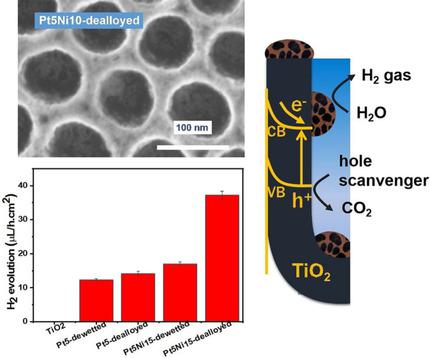当前位置:
X-MOL 学术
›
Chem. Asian J.
›
论文详情
Our official English website, www.x-mol.net, welcomes your
feedback! (Note: you will need to create a separate account there.)
A Dewetted-Dealloyed Nanoporous Pt Co-Catalyst Formed on TiO2 Nanotube Arrays Leads to Strongly Enhanced Photocatalytic H2 Production.
Chemistry - An Asian Journal ( IF 3.5 ) Pub Date : 2020-01-07 , DOI: 10.1002/asia.201901545 Lei Ji 1, 2 , Davide Spanu 1, 3 , Nikita Denisov 1 , Sandro Recchia 3 , Patrik Schmuki 1, 4 , Marco Altomare 1
Chemistry - An Asian Journal ( IF 3.5 ) Pub Date : 2020-01-07 , DOI: 10.1002/asia.201901545 Lei Ji 1, 2 , Davide Spanu 1, 3 , Nikita Denisov 1 , Sandro Recchia 3 , Patrik Schmuki 1, 4 , Marco Altomare 1
Affiliation

|
Pt nanoparticles are typically decorated as co-catalyst on semiconductors to enhance the photocatalytic performance. Due to the low abundance and high cost of Pt, reaching a high activity with minimized co-catalyst loadings is a key challenge in the field. We explore a dewetting-dealloying strategy to fabricate on TiO2 nanotubes nanoporous Pt nanoparticles, aiming at improving the co-catalyst mass activity for H2 generation. For this, we sputter first Pt-Ni bi-layers of controllable thickness (nm range) on highly ordered TiO2 nanotube arrays, and then induce dewetting-alloying of the Pt-Ni bi-layers by a suitable annealing step in a reducing atmosphere: the thermal treatment causes the Pt and Ni films to agglomerate and at the same time mix with each other, forming on the TiO2 nanotube surface metal islands of a mixed PtNi composition. In a subsequent step we perform chemical dealloying of Ni that is selectively etched out from the bimetallic dewetted islands, leaving behind nanoporous Pt decorations. Under optimized conditions, the nanoporous Pt-decorated TiO2 structures show a>6 times higher photocatalytic H2 generation activity compared to structures modified with a comparable loading of dewetted, non-porous Pt. We ascribe this beneficial effect to the nanoporous nature of the dealloyed Pt co-catalyst, which provides an increased surface-to-volume ratio and thus a more efficient electron transfer and a higher density of active sites at the co-catalyst surface for H2 evolution.
中文翻译:

在 TiO2 纳米管阵列上形成的脱湿脱合金纳米多孔 Pt 助催化剂可显着增强光催化氢气生产。
Pt 纳米颗粒通常被装饰为半导体上的助催化剂,以增强光催化性能。由于 Pt 的丰度低且成本高,以最小化的助催化剂用量达到高活性是该领域的一个关键挑战。我们探索了一种去湿脱合金策略,在 TiO2 纳米管上制造纳米多孔 Pt 纳米颗粒,旨在提高产氢助催化剂的质量活性。为此,我们首先在高度有序的 TiO2 纳米管阵列上溅射可控厚度(纳米范围)的 Pt-Ni 双层,然后在还原气氛中通过适当的退火步骤诱导 Pt-Ni 双层的去湿合金化:热处理使 Pt 和 Ni 薄膜团聚,同时相互混合,在 TiO2 纳米管表面形成混合 PtNi 成分的金属岛。在后续步骤中,我们对 Ni 进行化学脱合金,将其从双金属去湿岛中选择性地蚀刻掉,留下纳米多孔 Pt 装饰。在优化条件下,纳米多孔 Pt 修饰的 TiO2 结构与使用相当的去湿无孔 Pt 负载量修饰的结构相比,光催化产氢活性高出 3E6 倍。我们将这种有益效果归因于脱合金 Pt 助催化剂的纳米多孔性质,它提供了增加的表面与体积比,从而提供了更有效的电子转移和助催化剂表面上用于析氢的更高密度的活性位点。
更新日期:2020-01-08
中文翻译:

在 TiO2 纳米管阵列上形成的脱湿脱合金纳米多孔 Pt 助催化剂可显着增强光催化氢气生产。
Pt 纳米颗粒通常被装饰为半导体上的助催化剂,以增强光催化性能。由于 Pt 的丰度低且成本高,以最小化的助催化剂用量达到高活性是该领域的一个关键挑战。我们探索了一种去湿脱合金策略,在 TiO2 纳米管上制造纳米多孔 Pt 纳米颗粒,旨在提高产氢助催化剂的质量活性。为此,我们首先在高度有序的 TiO2 纳米管阵列上溅射可控厚度(纳米范围)的 Pt-Ni 双层,然后在还原气氛中通过适当的退火步骤诱导 Pt-Ni 双层的去湿合金化:热处理使 Pt 和 Ni 薄膜团聚,同时相互混合,在 TiO2 纳米管表面形成混合 PtNi 成分的金属岛。在后续步骤中,我们对 Ni 进行化学脱合金,将其从双金属去湿岛中选择性地蚀刻掉,留下纳米多孔 Pt 装饰。在优化条件下,纳米多孔 Pt 修饰的 TiO2 结构与使用相当的去湿无孔 Pt 负载量修饰的结构相比,光催化产氢活性高出 3E6 倍。我们将这种有益效果归因于脱合金 Pt 助催化剂的纳米多孔性质,它提供了增加的表面与体积比,从而提供了更有效的电子转移和助催化剂表面上用于析氢的更高密度的活性位点。











































 京公网安备 11010802027423号
京公网安备 11010802027423号